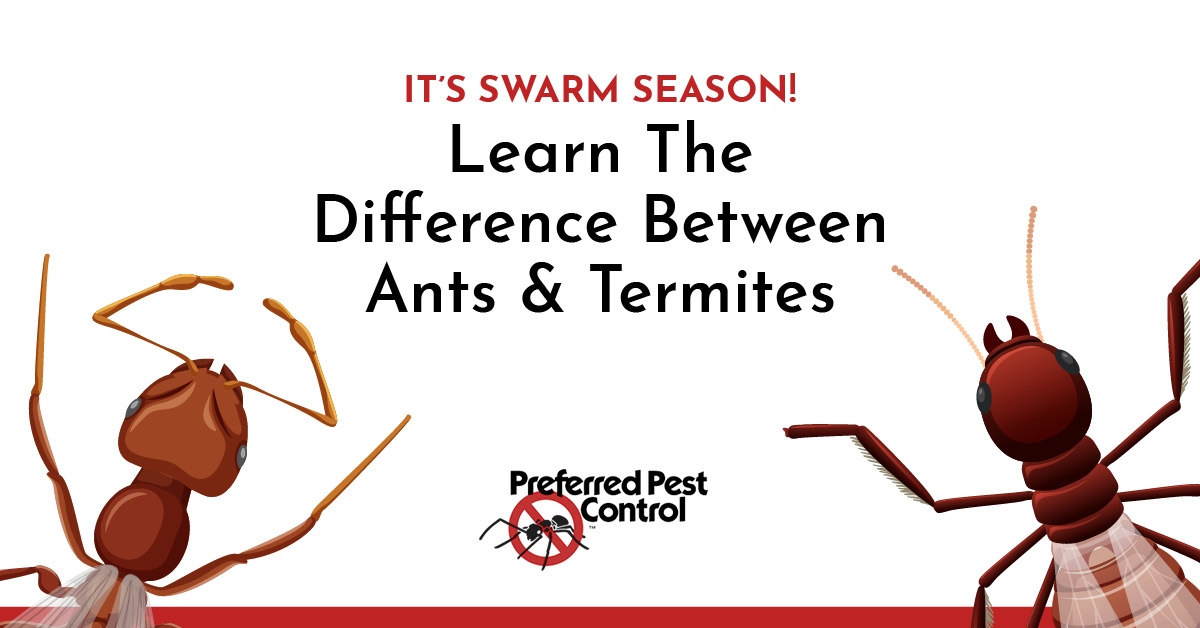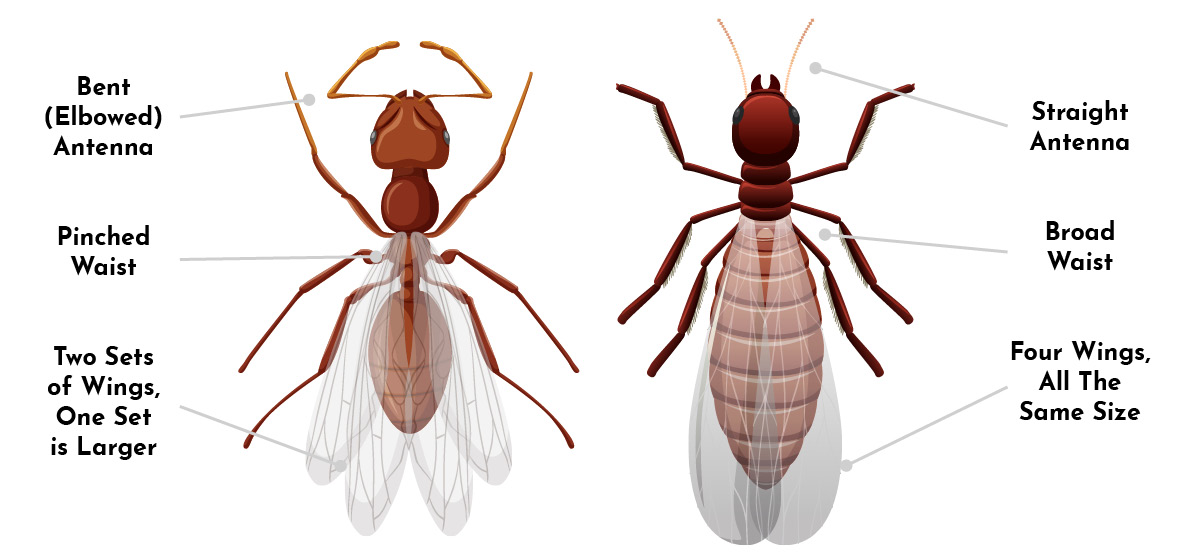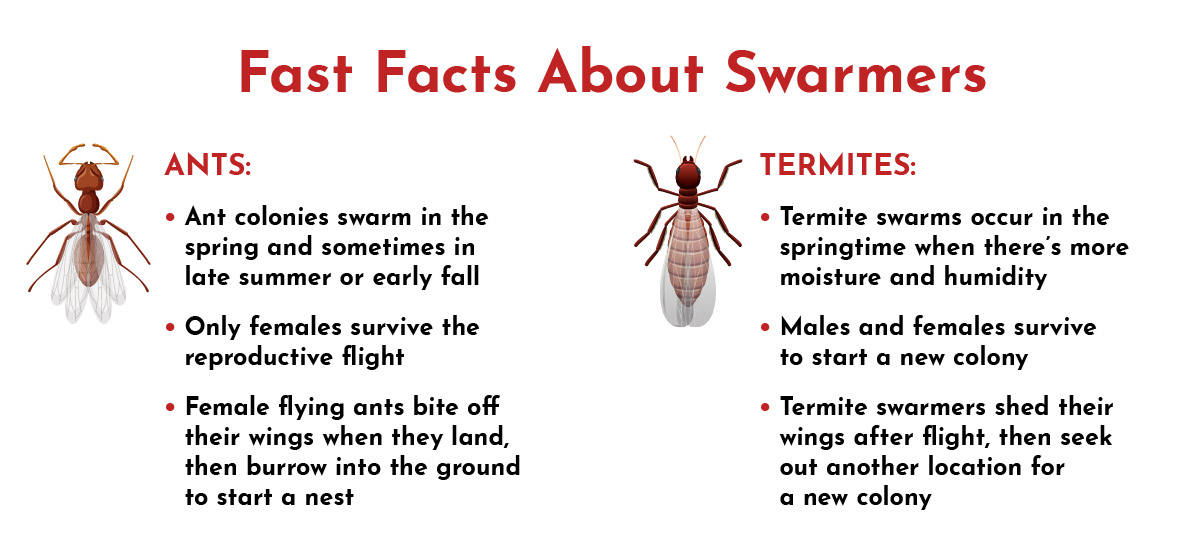
It's Swarming Season: Ant Swarmers vs. Termite Swarmers
April 10, 2023
Spring in Iowa is a much-anticipated time each year. After the long, cold winters we experience, the spring sun, flowers and warmth can be an extremely welcoming sight. Spring is when we finally begin to see our streets filled with families and kids playing outside, outdoor sports like baseball and softball begin and ice cream and popsicles are in high demand. But, this time of year attracts more than just us indoor dwellers after the long winter. There are a number of bugs and insects who have been in hiding all winter that begin to emerge from their nesting places.
Among these springtime insects are swarming termites. Swarming termites may cause alarm and confusion for homeowners experiencing the activity in and around their property. They can emerge by the thousands, and while this phenomenon is impossible to ignore, many homeowners mistake termite swarms for flying ants. Our pest control experts share clear differences between the two to help homeowners spot and prevent an infestation.
Do termites fly?
Yes, adult reproductive termites will fly, or “swarm”, to reproduce and create new colonies. Termites swarms are provoked during spring when there's heavy rainfall and warm, humid temperatures.
Termite swarmers are less likely to be seen than ant swarmers. However, the two closely resemble each other and can cause confusion among homeowners.
What do flying termites look like?
Termite swarmers have a straight antenna, broad waist and four equally-sized wings. The color of a termite depends on the species, but termite swarmers are typically darker. In general, termites average anywhere from 1/4 to 1/2 inch in length and the king and queen termites can grow as big as 1 inch long.
The Difference Between Flying Ants and Termite Swarmers
The most distinct differences between flying ants and termite swarmers lie within their appearances. Opposite of termite swarmers, winged ants will have a bent antenna and a pinched waist. They have two sets of wings; one is larger than the other.
Many homeowners mistake termite swarms for flying ants, therefore failing to take the necessary action to eliminate the infestation and colony. If you’ve made this mistake, don’t feel bad! Anyone who isn’t a pest professional will likely find it difficult to tell the difference between flying ants and termite swarmers. That’s why our pest control experts share tips to help decipher between the two.

Termite Swarmers
Termite swarms occur most often in early spring when the weather is warm and rainy. Termites use these environmental changes to know when it’s time to fly away to form their colonies. The weather synchronizes different termite colonies causing multiple swarms and reducing the chance of inbreeding. Swarming occurs during the daytime and is simply a reminder that termites are nearby.
If you encounter a termite swarm outdoors, it likely came from an existing, underground nest in your yard, probably near an old tree stump or other wood and debris. If the swarm is inside your home, you most likely have an infestation. Homeowners may see these swarmers or come across discarded wings. Contacting a pest professional is the most effective and efficient tactic to eliminate an established termite colony, regardless of where these swarms happen. Preferred Pest Control offers leading termite control services that include a full inspection with the option of having a one-time treatment or year-round check-ins.
Ant Swarmers
Ant swarms consist of male and female ants looking to mate and begin their new colonies like termites. Ant swarmers vs. termite swarmers are alike in their behaviors, and the two can be extremely hard to differentiate.
Depending on the species, flying ants swarm at different times throughout the year, especially in the spring and mid-to-late summer when the weather begins to warm up. Ant colonies will typically be about two to three years old before producing flying ants. Of those flying ants, only the females will survive the reproductive flight. Female flying ants are also known for biting off their wings when they land and burrow into the ground.

Do swarming termites mean infestation?
For many homeowners, the sudden appearance of swarming termites or flying ants may be one of the first signs of an indoor infestation. Both pests will attempt to make their way in through crevices, cracks in the walls, windows and foundations.
Regardless of the construction type, all homes can provide the ideal location for infestations of termites and ants. Although flying ants and termite swarmers thrive in different climates, both need four things to survive - food, shelter, moisture, and optimal temperature. The main difference between these two pests’ nesting habits is that termites will eat the wood they form a tunnel in and ants will only nest in it. Though you may find ants in dry wood, they prefer to nest in wet, damp or rotting wood.
Contact Preferred Pest Control For Termite Treatment in Des Moines
Have you spotted ant or termite swarms invading your home or property? Don't wait to get professional termite treatment! For efficient and immediate control, schedule an appointment online with Preferred Pest Control or give us a call at (515) 415-5550 today!